Everyone knows what a foundation is, but, perhaps, many hear about a grillage for the first time. When constructing a base from piles or reinforced concrete pillars, the grillage is required. Columnar-grillage foundation today is the most popular in individual construction, mainly due to its quick installation and inexpensive cost. It should be noted that this type of base is not inferior to concrete in terms of strength.
Feasibility of application
Before considering the question of when and where it is better to use a foundation of this type, it would not hurt to figure out what a columnar-grillage foundation is, what it is and when it is still more profitable to use it.
This type of foundation is based on opera pillars (piles or reinforced concrete structures), in order to evenly distribute the loads from the future building, all the supports are tied into one structure using a grillage, which fits in the upper part of the base.
If weak soils prevail on the construction site: sandy, sandy loamy clayey, then it is the columnar-grillage foundation that is most effective here. Thanks to it, piles or pillars can be immersed to the maximum depth, which will avoid the support of the support in unreliable and loose soils. 
In conditions where soils have a large freezing depth, the construction of a concrete foundation will be too expensive, therefore, in such areas it is also preferable to use pillars with a grillage as supports.
Piles, reinforced concrete, wood and metal posts can be used as supports. The last two options are used extremely rarely and only for light farm buildings. Most often, reinforced concrete is used for the supports of the columnar-grillage base.
How to make calculations
Before engaging in the construction of any foundation, it is necessary to conduct soil surveys and perform foundation calculations. This stage is the most important. So, the device of the columnar-grillage foundation begins:
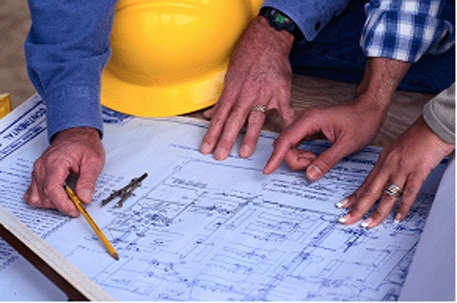
- each corner of the future building must be supported by a pillar;
- the areas where the walls intersect must be supported by additional pillar supports;
- as for straight sections, 2.5 m is quite a sufficient distance between the supports that meets all the requirements, but you should not choose more than 3.5 m, since such a distance is already insufficient.
The initial stage of all preparatory work begins with removing the sod over the entire area of \u200b\u200bthe future foundation. Further, in places where the pegs are driven in, they dig holes for the supports. The depth of the holes should be greater than the amount of soil freezing plus 20 cm for the middle lane. Additional centimeters are necessary in order to arrange a pillow, which will further contribute to the correct distribution of loads. The width of the trench will be equal to the width of the wall of the future building. From this size on each side of the pillar, plus another 20 cm are laid and the formwork is installed.
The construction of a columnar-grillage foundation begins with a cushion of slag or crushed stone, which must be carefully tamped. The material must be laid over the entire width of the pit. Roofing material is lined on top of the rammed slag. This requirement is due to the fact that moisture from concrete mortar was not absorbed into the ground while it was gaining strength.
How to make formwork
For these purposes, ordinary boards are suitable, a thickness of 2 cm will be quite enough. Their light weight makes installation easy and they are inexpensive. Shields are made of them, then - boxes. Then they are installed in prepared trenches. Be sure to thoroughly moisten the surface of each shield with water. This will prevent moisture from pulling out of the concrete, and in the future will facilitate the disassembly of the formwork.
Instead of boards, you can use asbestos or ceramic pipes. After pouring and hardening of the solution, they are left in the ground. It is allowed to completely avoid the installation of formwork, if in the prepared trench the strong walls do not crumble, and the size fully corresponds to the calculations made. In order to prevent moisture from the concrete solution from absorbing into the ground, it is enough to insulate the walls with a simple plastic wrap. But for safety reasons, formwork is still better to use.
How to reinforce foundation pillars
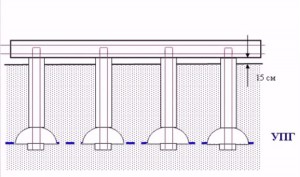
The columnar-grillage foundation for gas silicate must be carried out with the obligatory reinforcement of the supports for it. Reinforcing bars are used for the skeleton. The diameter will fit both 10 and 14 mm. Having retreated 5 cm from the edge of the trench, the reinforcement is placed in the pit and welded to the horizontal rods.
The distance between the horizontal rods is about 40 cm. It is important to remember that the longitudinal rods in length should be such that after pouring the entire amount of the solution, the rods have free ends equal to at least 30 cm. (Usually 30-40 cm are left). It is better to leave more than less, as the extra centimeters can always be cut off. To these ends, the grillage frame from reinforcement will be welded further. The reinforcement skeleton should be assembled directly on the ground, and only then, when assembled, it should be lowered into the dug trench.
Pouring concrete mortar
When the formwork is exposed and the metal skeleton is lowered into the trench, you can start pouring concrete. It is poured in layers. The thickness of each is approximately 30 cm. Each poured layer must be bayonetted to remove excess air and make the concrete dense and durable.
The filling technology is as follows. The first layer is poured, carefully bayonetted by hand or with a tool, then the next one is poured. It is highly not recommended to fill in half of the solution today, and the other tomorrow, since a butt joint will appear at the joint at the junction, reducing its bearing capacity.
The formwork can be removed after 4 days. The surface of each support must be covered with waterproofing or treated with a special material. Only then can the support be covered with earth. If the site contains mainly loose clay soil, then it is better not to return it to the pit, but to fill it with sand with careful tamping.
Installation of grillage
The use of a columnar-grillage foundation allows the grillage to be mounted from both monolithic and prefabricated reinforced concrete. You can often hear a variety of opinions about how far from the ground the grillage should be directly located. But its depth is determined by several parameters. For example, it is unacceptable to mount the grillage close to the ground level, when loose and heaving soils prevail on the sites.
And the grillage is laid in the formwork prepared in advance, which ties together all the support pillars. A layer of sand is poured onto the bottom of the formwork (it is advisable to use larger fractions) and carefully tamped.
The second stage is made metal carcass, which is laid in the mold and welded to the ends of the retained reinforcement of the supports themselves. Next, the solution is poured, removing air from it. When the mortar has completely hardened, the formwork is removed, along with a layer of sand. As a result, the columnar-grillage foundation, which can last for many decades, is completely ready. The most important thing is to comply with all calculations and requirements, especially when soil surveys are being carried out on the site for construction.
M100 | B7.5 M150 | B10 M150 | B12.5 M200 | B15 M250 | B20 M300 | B22.5 M350 | B25 M350 | B26.5 M400 | B30 M450 | B35 M550 | B40 M600 | B45 Select the grade (class) of concrete you want to receive. M100 (B7.5) Due to its low strength, it is mainly used for preparatory concrete work. Can be used as a "pillow" for a foundation, curb, paving slabs, road bed, etc. M150 (B12.5) Concrete of this grade has sufficient strength for pouring different types foundation for small structures. Also used for pouring floor screeds, laying concrete paths. M200 (B15) One of the most demanded brands of concrete (along with M300) used in suburban construction. The main application: pouring the foundation (pillar-grillage, tape, slab), making concrete paths, walls, stairs. M250 (B20) It is used for pouring foundations, lightly loaded floor slabs, making stairs, retaining walls. M300 (B22.5) Along with the M200, it is very popular in private construction. This brand of concrete, due to its versatility, allows it to be used for pouring the foundation for almost any house in the suburban sector, as well as for the manufacture of tapes of fences, floor slabs. M350 (B25) Main application: production of floor slabs, load-bearing walls, columns, reinforced concrete products and structures, casting monolithic foundations. M400 (B30) It is rarely used in suburban construction. It is used for the manufacture of cross beams, retaining walls, structures of bridges and hydraulic structures, pouring bowls of pools, basements of monolithic buildings. M450 (B35) Main application: bank vaults, bridge structures, metro construction, hydraulic structures. M550 (B40) Main application: reinforced concrete structures for special purposes (storage of banks, dams, dams, metro construction). M600 (B45) Main application: foundations for complex and large-scale objects, bridge supports, hydraulic structures, special purpose objects (bunkers, etc.). http: //www.site
Columnar foundations are successfully used on dense non-porous soils in individual construction. But such a structure, which is advantageous in terms of cost and construction speed, cannot be used on soft soils subject to heaving or horizontal shifts.
However, owners of dysfunctional land plots should not despair: a good option has been invented for them - columnar foundation with a grillage.
The grillage is called the horizontal strapping of the posts into a single system. This design allows you to distribute the load from the aboveground part of the structure evenly between the posts. The grillage can be steel beams, wooden beams or reinforced concrete.
The material is selected depending on what building materials are planned to be used for the construction of the building:
- steel and monolithic reinforced concrete - for the construction of large buildings from metal structures, bricks;
- wood - for building small wooden houses, baths, sheds and other unresponsible structures.
Application area
The scope of columnar - grillage foundations is quite wide:
- with threats of frost heaving;
- when erecting the walls of the above-ground part of the building from brick;
- in cases where too deep subsidence of the supports is unacceptable.
Diagram of a columnar - pile foundation with a grillage:
Design features of grillages
The grillage can occupy one of the following spatial positions:
- the sole is at ground level;
- a guaranteed gap is provided between the base of the grillage and the surface of the ground;
- the bottom of the grillage is located below ground level.
Wooden grillage
It is not recommended to deepen a wooden grillage for a columnar foundation, as moisture negatively affects the wood. But there is an exception to this rule: valuable wood species - for example, larch - are not afraid of water.
And on non-porous soils at a level groundwater below the freezing level, even pine can be placed on the ground. Loose soils require a device sand pillow under the logs.
Practice shows that it is still better to raise a wooden grillage above ground level by at least 100 mm (increased grillage). If the gap between the tree and the ground exceeds 250 mm, such a grillage is called high.
A grillage from a bar on a columnar foundation is arranged in the same way as from a log. When buying bars, you need to pay attention to the parallelism of opposite edges: a variable section of the bar is not allowed.
Metal grillage
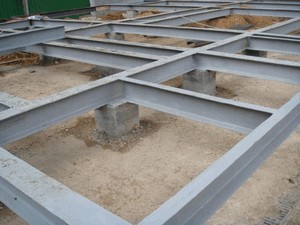 A grillage made of steel beams is not the best option for individual construction:
A grillage made of steel beams is not the best option for individual construction:
- firstly, metal costs a lot of money;
- secondly, one cannot do without the help of construction equipment and a team of builders. And this will significantly increase the cost of the foundation.
The durability of the steel grillage is also low: no matter how you process the metal, sooner or later rust will destroy it.
Reinforced concrete
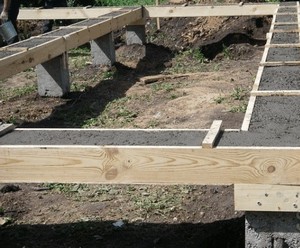 Reinforced concrete grillage can be prefabricated or monolithic. The prefabricated structure is not suitable for private construction due to the large weight of reinforced concrete products.
Reinforced concrete grillage can be prefabricated or monolithic. The prefabricated structure is not suitable for private construction due to the large weight of reinforced concrete products.
Just as with the arrangement of the steel strapping of the posts, the participation of special equipment and professional workers will be required.
A columnar foundation with monolithic grillage: you can install the formwork, mount the reinforcing frame, prepare and pour concrete with just one assistant.
Reinforcement of columnar - grillage foundation
 To reinforce a columnar foundation with a grillage, reinforcement is used:
To reinforce a columnar foundation with a grillage, reinforcement is used:
- for longitudinal rods - class AIII with a diameter of 6 mm (for the device of the grillage frame) and 12 mm (for pillars);
- for cross rods - class AI.
Cross bars are knitted every 200 mm.
Calculation of a columnar - pile foundation
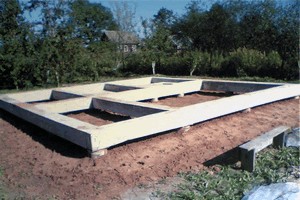 It is unacceptable to start building a foundation of any structure without calculating its parameters.
It is unacceptable to start building a foundation of any structure without calculating its parameters.
To perform the calculation of a columnar foundation with a grillage, it is necessary to collect a lot of initial data:
- the weight of building materials (all without exception): you need to know this to calculate the total load on the foundation;
- snow load is a normative parameter that differs depending on the region. For the Moscow region, it is 100 kg for each square meter roofs;
- the bearing capacity of the soil, which will serve as the basis for the pillars.
The last point brings the most problems in the construction of small buildings: geological studies are expensive.
Many developers follow a simplified path: they take the bearing capacity of the soil equal to 0.5-0.6 kg / sq. cm.
This parameter is typical for peatlands or old drained bogs. By choosing the obviously worst soil option, the developer gets a good safety factor for his foundation.
Before making a grillage for a columnar foundation, you need to make a decision: you are going to arrange it high or low, what material is more accessible to you, how heavy the building you are going to build.
Video about a columnar foundation with a grillage.
The quality of the foundation determines how strong and durable the building will be. Nowadays, advanced technologies are used in construction, allowing you to quickly and efficiently build any structure. These include a columnar foundation with a grillage, the price of which is quite low.
There are several classifications of foundations from which you can easily choose the option suitable for the consumer. After all, not all types of soil can be used to build a building. Moreover, specifications (the depth of the laying, the material used) have a significant impact on the quality of the future building.
Depending on the material used for construction, they can be:
- stone (rubble, brick, rubble concrete);
- reinforced concrete (they are subdivided into prefabricated and monolithic);
- wooden.
Columnar foundation is laid below the depth of soil freezing, otherwise the piles can be pushed out by frost heaving
By type of construction, they are divided into:
- tape;
- slab (solid);
- columnar;
- pile.
In suburban construction, due to the ease of installation and the availability of materials, columnar and tape types are most often used.
Tape
Based on the name, it is easy to guess that he is a tape around the entire perimeter of the building. Such types, in turn, are subdivided into prefabricated and monolithic.
The strip base is often used, because on such a foundation it is possible to build any house, from a monolithic one to a wooden one, without large financial and physical costs.
The tape type has a lot of advantages:
- small price, but in comparison with a columnar foundation with a grillage, the cost is slightly higher;
- sustainability;
- long service life;
- the ability to carry out work at any time of the year;
- versatility - the ability to use for buildings of any type.
 Its scope is the construction of foundations for brick and block houses.
Its scope is the construction of foundations for brick and block houses.
Plated (solid)
This type is located under all superstructures in the form of a slab. It is used for construction multi-storey buildingswhere it is required to redistribute the load on the base, while reducing the load on the weak areas of the soil and increasing the strong areas.
If the site has a high level of groundwater located on weak soils, this is the best view... It is resistant to any type of deformation and can perfectly cope with the largest loads without any loss of functionality. In addition, its service life is quite long.
But compared to other types, the erection slab foundation do it yourself is a laborious process that requires financial investments.
Columnar
This type of foundation is one of the best solutions for the construction of small structures in the form of a bath, veranda and other wooden frame-type houses.
Columnar foundation is the least costly in terms of labor intensity and finance
If the project does not provide for the construction of basements, the load on the ground is very small. Therefore, the columnar foundation is here, like nowhere else. Also, the price of a columnar foundation with a grillage, provided that it is built with your own hands, is quite insignificant.
Therefore, in suburban construction, it is better to use this quick method, without harming the quality along the way. The price for building a columnar foundation with a do-it-yourself grillage is 75% less than a similar strip foundation.
Pile
For the layman to erect pile foundation with your own hands is difficult enough. More often it is used to erect buildings on weak soils... Moreover, it is subdivided into rack piles and hanging piles... Depending on how the load is transferred to the ground, one type or another is used.
A pile foundation with a recessed grillage is a special type of foundation that is particularly durable. It is most often used in the construction of aerated concrete and brick buildings.
More details about the features of each type of foundation and its price can be found in the table:
| Complexity assessment | Reliability assessment | Terms of execution (days) | Price (thousand rubles per 1m2) | The main advantage | The main disadvantage | |
| Pile-screw foundations | 3 | 8 | 1-2 | 100 | price-timing combination | impossibility of laying on rocky soils |
| Platen foundation | 6 | 9 | 35 | 570 | reliable | high price |
| Column foundation | 4 | 3 | 10 | 280 | ease of bookmarking | uneven load leading to building collapse |
Rostwerk: what is it?
 The grillage is part of the columnar foundation, located at the top and distributing all the load. In addition, it is a kind of support for the entire structure. It looks like beams that unite the head of the pillars.
The grillage is part of the columnar foundation, located at the top and distributing all the load. In addition, it is a kind of support for the entire structure. It looks like beams that unite the head of the pillars.
Foundations with a grillage can be of the following types:
- tape;
- solid.
The choice depends on:
- soil;
- materials used;
- ways of devices.
Wooden grillage for a columnar foundation is widely used in country construction. This is the ideal type of foundation for building wooden house, baths, verandas, etc. But it can be made not only from wood, but also from other materials. Although, of course, its price will be much higher.
How to make a columnar foundation with a grillage with your own hands
Many summer residents ask the question of how to make a columnar foundation with a grillage for a bath or veranda with their own hands. This is not as difficult as it might seem at the beginning.
Have homemade piles load bearing capacity low, therefore careful calculation of loads is important
The technological process includes the following stages:
- payment;
- land works;
- production of formwork for pillars;
- reinforcement of a columnar foundation with a grillage;
- pouring concrete;
- grillage device.
Payment
This stage is the most important, since the reliability and strength of the whole building depend on it. Calculations can be easily performed using special tables. They can be found easily on the internet.
Land works
As in any construction, site preparation has great importance and takes a lot of money and effort.
The main works are as follows:
- free the site from any vegetation;
- mark the territory, and dig a shallow hole along the entire length and width;
- mark the places where the pillars will be located, make recesses;
- fill the holes to the level of freezing of the ground plus 20 cm under the pillow;
- put a pillow there, consisting of gravel and sand.
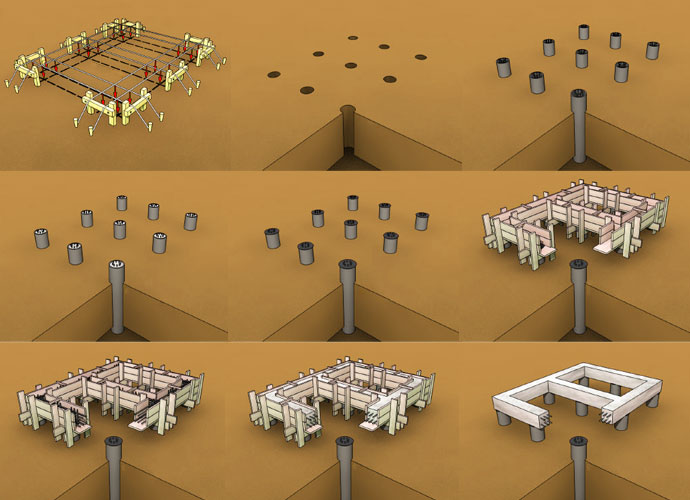
With a small construction, you can easily get by with the tools at hand, without using special equipment.
Formwork for pillars
Metals or wood are used as formwork... For suburban construction it is cheaper and easier to use the latter construction material... The thickness of the wood must be more than 2 cm.
The works are as follows:
- collect the prepared boards into shields, from which it will be necessary to make boxes;
- put the resulting structures in the pits;
- moisten the formwork with water.
As a formwork, asbestos pipes are perfect, which are notable for their low price and excellent quality.
Reinforcement of a columnar foundation with a grillage
For these purposes, rods with a cross section of 1-1.6 cm are used.However, their the dimensions must be selected in accordance with the grillage frame... Assembly is done externally. The rods are held together with horizontal straps by welding or tying. The last option is the easiest.
It is preferable not to weld the reinforcement, but to tie it, but in home construction it is welding that is more often used
It is preferable to use rods with a diameter of 6 mm. They are installed with a step of 30-40 cm. Vertically, the reinforcement is connected using a reinforced grillage mesh. Therefore, in the beginning there is a little of her raise, above the head of the post by 30-40 cm, and then, after completion of assembly work, reinforce in the recess for the post.
Pouring concrete
Further actions will not take much time: the dug hole must be filled with concrete. Moreover this process must be divided into several stages: pour a layer about 25 cm thick, gouge, and level everything, removing air pockets that reduce the stability of the building.
Grillage device
It can be of different heights, located both above the ground and directly in the ground. Which is better is difficult to say. There is no consensus on this issue.
The sequence of actions is as follows:
- make the formwork between all the elements along the entire length. For this, sand is used;
- cover sand, for example, with plastic wrap;
- make and place a frame in the formwork;
- weld or tie the pile rods by combining the grillage with the grid;
- pierce the solution with fittings, removing excess air bubbles;
- when the concrete is dry, the formwork can be taken out;
- remove the sand layer;
- strengthen the resulting structure with brick supports.
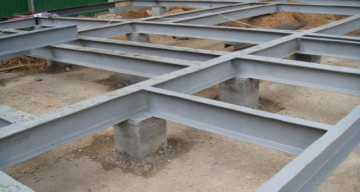
So, the process of creating a columnar foundation with a grillage for frame house or other buildings can be easily done by hand. This is the simplest and most cost-effective solution.
The price of a columnar foundation with a grillage
The cost of the finished product of this type is the lowest. In general, it depends on the volume construction works and prices of materials . The price of a columnar foundation with a grillage also depends on the technology for erecting the foundation and the depth of the foundation. Average the price is from 25000 rubles (building 6X6)... The price does not include land work, or rather the alignment of the site.
Of course, if you do everything yourself, the cost will be much lower.
More details on how to make a columnar foundation with a grillage with your own hands can be seen in the video:
Almost everyone understands that the foundation is the basis of a strong and durable building, and therefore the service life and operation of the building will depend on the quality of the work performed. Today, a number of advanced technologies are used in their construction, which allow creating a full-fledged structure as quickly as possible without loss of quality. These include the creation of a columnar foundation using a grillage.
What is a grillage and a foundation with a grillage?
A grillage is a part of a columnar foundation, which is located at its top and distributes the load between all the pillars, and also serves as a support for all elements of the building. The grillage has the form of beams, the design of which unites the heads of the posts. Usually the grillage is made of wood, less often of metal, but modern construction uses reinforced concrete or concrete.
A foundation with a grillage is already a structure that has a reinforced upper part that unites the head of the pillars. It is of two types:
- tape;
- solid.
The type of foundation used depends on the following indicators:
- soil;
- material;
- device method.
Pros and cons
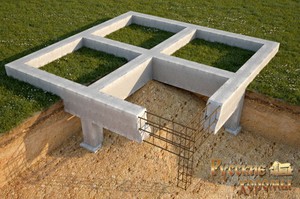 The main advantages of a columnar foundation with a grillage are:
The main advantages of a columnar foundation with a grillage are:
- The scope is unlimited. It can be built on clay, rocky, hard and unstable soils. The relief of the site also does not matter, which saves the architect from standard solutions and high construction costs;
- Competent installation will provide the building with durability (over 70 years);
- Relatively low price;
- It is possible to select the type and type of foundation and its grillage, which makes it possible to save on the price and timing of the work;
- The simplicity of the technology makes it possible to build the foundation yourself.
But, in addition to the above advantages, there are several disadvantages:
- the inability to build a basement or cellar;
- low resistance to soil deformation during the heaving process.
Calculations of a columnar foundation with a grillage
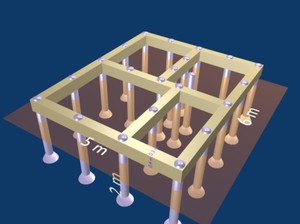 Undoubtedly, it would be better to entrust the implementation of the first calculation stage for the construction of the foundation to specialists, but if the budget is limited, you can try to figure it out yourself with the help of technical literature and the Internet.
Undoubtedly, it would be better to entrust the implementation of the first calculation stage for the construction of the foundation to specialists, but if the budget is limited, you can try to figure it out yourself with the help of technical literature and the Internet.
The calculation stage includes the following steps:
- geological surveys. They are required to determine the load per unit of soil area, which, therefore, will determine the support area of \u200b\u200bthe future columnar foundation, which must support the entire weight of the constructed building. The existing load per 1 sq. see soil can be found in technical literature;
- calculating the weight of the building. This indicator depends on the material used during construction, as well as the existing load from wind and snow;
- calculation of the area of \u200b\u200bthe base of the columnar foundation. This indicator can be obtained by dividing the approximate weight of the building by the weight that can withstand 1 sq. see soil. To equalize the calculations, the resulting indicator is increased by 25-30%;
- number of pillars. This indicator is obtained by dividing the area of \u200b\u200bthe base of the foundation by the area of \u200b\u200bthe base of one pillar.
After the calculations, there is a stage of marking the foundation with a grillage, where an important point is marking the place where the holes for the piles will be located. There are recommendations for installing supports:
- the presence of a support at each corner of the building;
- the presence of support at the intersection of the walls;
- if there are no corners and intersected walls along the foundation line, the distance between the supports is 2.5-3.5 meters. If the supports are installed more often, this will increase the cost of building material, if less often than every 3.5 meters, then the building may deform, which will lead to cracks.
How is the columnar grillage foundation arranged?
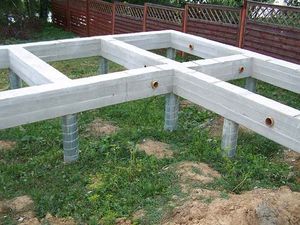 The device of a columnar grillage foundation is not so complicated. The main elements of the foundation are supporting supports (pillars), which can be made of various materials: concrete, rubble stone, brick, metal pipes.
The device of a columnar grillage foundation is not so complicated. The main elements of the foundation are supporting supports (pillars), which can be made of various materials: concrete, rubble stone, brick, metal pipes.
As mentioned above, the pillars are installed at the corners and at the intersections of the walls, and the step of their installation depends on the structure and the expected load of the building.
Calculations of the diameter of each support are made for each building individually. The depth should be below the level of freezing of the soil, and the lowest point of support is placed in a stable layer of soil. A prerequisite is the presence of grillages for a bundle of pillars to distribute the load on all existing elements of the building structure.
Erection of a columnar grillage foundation
If you want to do without specialists (engineers, architects) and start building a house or structure on your own, then you should take into account several main aspects:
- type of grillage. It depends on the type of soil and the properties of its movement;
- construction of the future structure. Area, number of floors, building material affect the pressure level;
- location relative to the soil.
Stages of the construction of a columnar foundation with a grillage:
- Estimated. The theoretical part was presented above.
- Preparatory. It includes clearing the site from all irregularities, as well as planning the site according to your project. To check if the stakeout is correct, you need to measure the diagonals and angles. The vertical pillars can be dug manually or with a drilling rig. It is important not to miss the moment and arrange the formwork at a depth of one meter to prevent the soil from shattering. The width of the dug hole should include the dimensions of the post, formwork and spacers.
- Formwork installation. Usually they use wooden boards, less often plywood with moisture-resistant properties, wood-based panels, metal sheets.
- Reinforcement. It is carried out using a metal rod up to 1.5 cm thick, which are tied together in a horizontal position with a wire. In order to connect the post with the grillage, it is necessary to provide for the installation of the reinforcement in a vertical position above the support at a distance of 1.5 cm.
- Pouring with concrete mixture. It is produced in several layers, each of which is 2 cm. Each layer is compacted with a hand vibrator.
- Waterproofing. It is carried out by laying any waterproofing material inside the formwork.
- Installation of the pick-up. A backbone is a wall that covers the empty space under the columnar foundation. It is needed for communications, as well as to avoid the ingress of cold air and various precipitation. The best option there will be a preliminary thought over the pick-up before the foundation begins, since then it will be more difficult and inconvenient to do it. Brick can serve as a material for picking up. The pick-up device includes ventilation and communication holes. The only drawback of the pick-up is its possible settlement under the influence of ground movement.
The final step is to remove the formwork and grout the ends.
The construction of a columnar foundation with a grillage is a profitable option for a low-rise building on complex, swampy and sandy soils that are mobile. And the ease and speed of installation does not require the help of special equipment, unlike a slab foundation.



